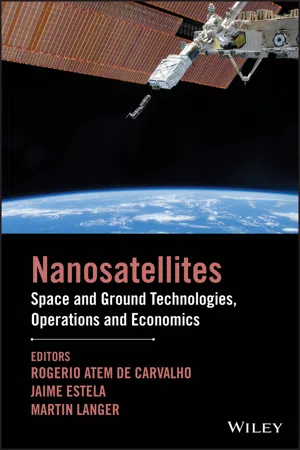
Nanosatellites
Space and Ground Technologies, Operations and Economics
- English
- ePUB (mobile friendly)
- Available on iOS & Android
Nanosatellites
Space and Ground Technologies, Operations and Economics
About This Book
Nanosatellites: Space and Ground Technologies, Operations and Economics
Rogerio Atem de Carvalho, Instituto Federal Fluminense, Brazil
Jaime Estela, Spectrum Aerospace Group, Germany and Peru
Martin Langer, Technical University of Munich, Germany
Covering the latest research on nanosatellites
Nanosatellites: Space and Ground Technologies, Operations and Economics comprehensively presents the latest research on the fast-developing area of nanosatellites. Divided into three distinct sections, the book begins with a brief history of nanosatellites and introduces nanosatellites technologies and payloads, also explaining how these are deployed into space. The second section provides an overview of the ground segment and operations, and the third section focuses on the regulations, policies, economics, and future trends.
Key features:
- Payloads for nanosatellites
- Nanosatellites components design
- Examines the cost of development of nanosatellites.
- Covers the latest policies and regulations.
- Considers future trends for nanosatellites.
Nanosatellites: Space and Ground Technologies, Operations and Economics is a comprehensive reference for researchers and practitioners working with nanosatellites in the aerospace industry.
Frequently asked questions
Information
1 I-1
A Brief History of Nanosatellites
1.1 Introduction
1.2 Historical Nanosatellite Launch Rates

Table of contents
- Cover
- Table of Contents
- List of Contributors
- Foreword: Nanosatellite Space Experiment
- Introduction by the Editors
- 1 I-1: A Brief History of Nanosatellites
- 2 I-2a: On-board Computer and Data Handling
- 3 I-2b: Operational Systems
- 4 I-2c: Attitude Control and Determination
- 5 I-2d: Propulsion Systems
- 6 I-2e: Communications
- 7 I-2f: Structural Subsystem
- 8 I-2g: Power Systems
- 9 I-2h: Thermal Design, Analysis, and Test
- 10 I-2i: Systems Engineering and Quality Assessment
- 11 I-2j: Integration and Testing
- 12 I-3a: Scientific Payloads
- 13 I-3b: In-orbit Technology Demonstration
- 14 I-3c: Nanosatellites as Educational Projects
- 15 I-3d: Formations of Small Satellites
- 16 I-3e: Precise, Autonomous Formation Flight at Low Cost
- 17 I-4a: Launch Vehicles—Challenges and Solutions
- 18 I-4b: Deployment Systems
- 19 I-4c: Mission Operations
- 20 I-5: Mission Examples
- 21 II-1: Ground Segment
- 22 II-2: Ground Station Networks
- 23 II-3: Ground-based Satellite Tracking
- 24 II-4a: AMSAT1
- 24 II-4b: New Radio Technologies1
- 25 III-1a: Cost Breakdown for the Development of Nanosatellites
- 26 III-1b: Launch Costs
- 27 III-2a: Policies and Regulations in Europe
- 28 III-2b: Policies and Regulations in North America
- 29 III-2c: International Organizations and International Cooperation
- 30 III-3a: Economy of Small Satellites
- 31 III-3b: Economics and the Future
- 32 III-3c: Networks of Nanosatellites
- Index
- End User License Agreement